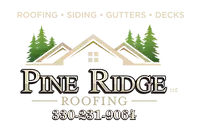Stow Roof Damage by Weather Conditions and Insurance Claims - A Comprehensive Guide
Your residence is not just a home; it’s a sanctuary. The role of your roof in upholding its safety and security is pivotal. However, when the inevitable roof damage by weather conditions strikes, understanding the various types of damage caused by the elements, mastering the insurance claim process, and implementing effective roof maintenance practices become crucial for safeguarding your investment.
This all-encompassing guide is your companion in navigating through the essentials, empowering you to protect your home and confidently handle “roof damage by weather conditions and insurance claims.”
In Stow, roof damage resulting from severe weather conditions such as storms, high winds, tornadoes, and hail is a frequent occurrence, and Pine Ridge Roofing is poised to provide support in addressing these issues.
Key Takeaways
Table of Contents
Stow Roof Damage - Types of Weather-Related Roof Damage
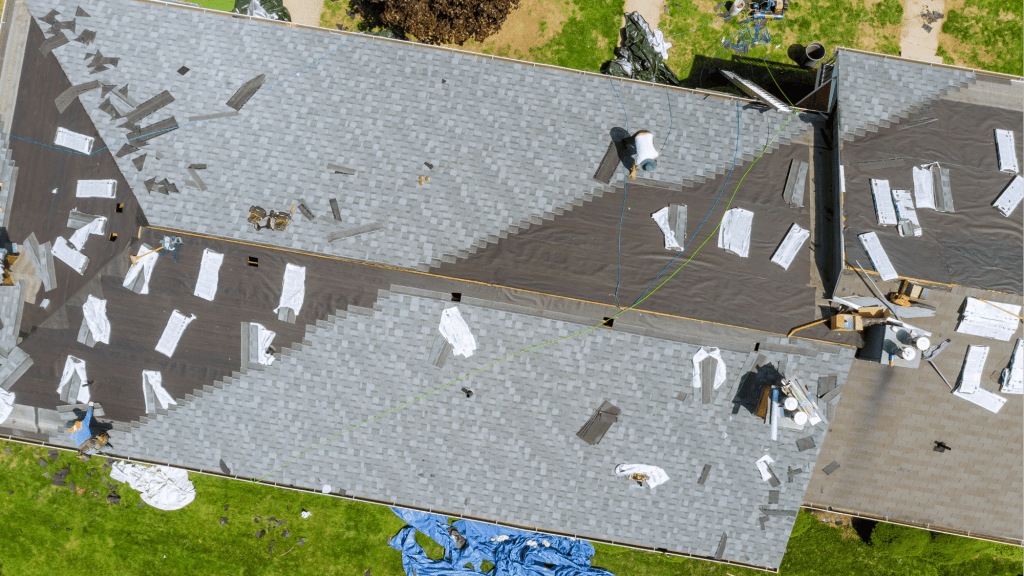
In Stow, roof damage due to inclement weather is a frequent issue. The capricious nature of weather elements such as wind, hail, rain, or snow often results in substantial damage, leading to insurance claims and the necessity for expensive repairs or replacements.
Safeguarding your home entails identifying the signs of storm damage and comprehending how these natural forces affect your roofing materials.
The question of whether roof damage is covered by insurance becomes significant. To secure coverage for your roof damage expenses under home insurance, it’s imperative to prove that the damage directly stems from an extreme weather event.
Wind Damage
In Stow, roof damaged by high winds can be a silent enemy to your roof, causing missing shingles, lifted flashing, or cracked tiles and they can also blow off your entire roof. These types of damage might seem minor at first, but they can lead to leaks and structural damage over time, making it necessary to go through the roof insurance claim process. Repairing an older roof can be challenging, as older shingles might lack flexibility and may crack during the repair process, leading to further issues. When dealing with a roof damage insurance claim, it’s important to engage a qualified roofing specialist to properly make a roof inspection and address the damage.
Gaining insight into the specific wind insurance coverage within your homeowner’s insurance policy will enable you to be better prepared for adverse weather conditions, particularly during storm events.
Wind damage can result from various weather events, such as severe storms or hurricanes. Monitoring your roof’s condition after these events and acting swiftly if visible signs of wind damage are noticed is of great importance. If you discover a heavy tree branch on your roof, it is advised to have it removed by a professional in a safe manner to prevent further damage and potential roof damage claims.
Hail Damage
When a hailstorm makes landfall, it can wreak havoc on your roof, causing dents, punctures, and shingle granule loss. Even though this kind of damage may go unnoticed by the untrained eye, its impact on your roof’s lifespan and effectiveness can be substantial. Hail has the ability to bruise or crack the shingle mat, creating vulnerabilities that allow water to gradually infiltrate your home, potentially resulting in the need for a roof claim.
Roof inspection for hail damage can be challenging, especially after a storm. Insurance adjusters and roofing professionals often consider metal components surrounding the roof, such as:
- Roof vents
- Pipe boots
- Gutters
- Roof flashing
It is essential to exercise caution and avoid inspecting the roof immediately after a storm, especially if it has a steep slope. In cases of significant hail damage, swift action, such as securing tarps to the roof, is imperative to prevent further deterioration from rainwater.
Rain and Snow Damage
Rain and snow may seem harmless, but they can wreak havoc on your roof if not properly managed. Here are some potential issues caused by rain and snow:
- Leaks and water damage
- Structural issues
- Roof collapse due to the weight of accumulated snow
- Ice dams, which can damage your roof and gutters
It’s important to take steps to protect your roof from these potential problems.
Employing preventative tactics, such as regular inspections, ensuring ample ventilation, and effective waterproofing, is crucial to protect your property from the damaging effects of rain and snow. Stay ahead by actively managing your roof’s maintenance and gaining insight into homeowner’s insurance coverage options like Actual Cash Value (ACV) and Replacement Cost Value (RCV) policies, thereby reducing the likelihood of facing substantial expenses for repairs or replacements caused by weather-related damage.
Stow Roof Damage - Insurance Coverage for Weather-Related Issues
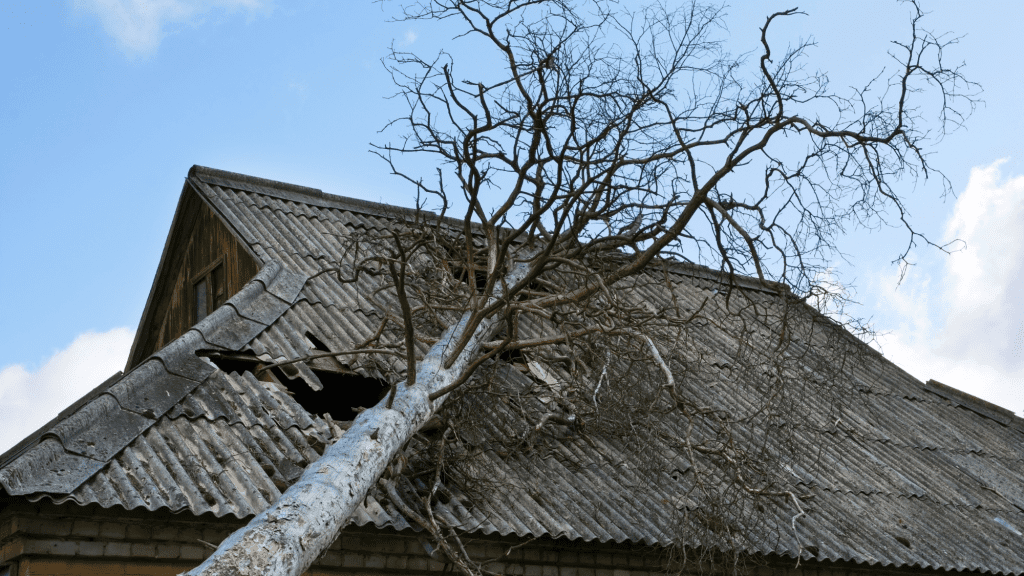
The insurance company plays a vital role in providing financial protection in the event of unexpected roof damage in Stow, Ohio. However, navigating the complexities of insurance coverage can be daunting. Understanding the differences between policy types, such as Actual Cash Value (ACV) and Replacement Cost Value (RCV), and being aware of common exclusions can make a significant difference in how your claim is handled and ultimately settled.
Policy Types: ACV vs RCV
An Actual Cash Value (ACV) policy is structured to cover the replacement of your roof by reimbursing you for its depreciated value, after deducting the applicable deductible. This implies that you’ll receive compensation based on the current value of your roof at the time of the damage. However, it’s crucial to note that this amount may not suffice to cover the entire cost of repairs or replacement.
On the other hand, a Replacement Cost Value (RCV) policy provides more comprehensive coverage. It covers the complete cost of roof replacement, offering funds for a new roof based on current market prices and materials. Under an RCV policy, you’ll initially receive a check for the actual cost value of your roof. After the roof replacement is finalized, a second check for the remaining amount will be issued, subject to meeting all specified requirements.
The choice of a suitable policy for your needs can greatly impact the payout you receive in the event of a roof damage claim, making it an important decision. It is essential to:
- Review your insurance policy
- Understand the differences between ACV and RCV
- Consult with your home insurance company to ensure you have the appropriate coverage for your specific situation.
Common Exclusions
Preserving your home from weather-related roof damage in Stow, Ohio, with homeowners insurance is a wise choice, but it’s essential to be mindful of common exclusions that may affect your claim, such as:
- improper installation, where deviating from the manufacturer’s instructions or local building codes during roof installation can lead to accelerated wear and tear, potentially invalidating your roof’s warranty.
- Lack of maintenance is another exclusion to watch out for, involving neglecting routine roof upkeep such as cleaning gutters and removing debris. Damages resulting from inadequate maintenance may not be covered by your insurance policy.
- Additionally, specific weather events, like hurricanes or earthquakes, may be excluded from coverage in some policies.
A careful review of your insurance policy is crucial to understand these exclusions and ensure you have the appropriate coverage for your roof. Inadequate maintenance occurs when a roof is not regularly inspected and maintained according to the manufacturer’s instructions or local building codes, possibly resulting in premature deterioration and warranty invalidation.
Understanding these exclusions and taking proactive measures to ensure proper roof installation, regular maintenance, and protection from excluded weather events can help you avoid potential claim denials and ensure you receive the coverage you deserve.
Stow Roof Damage - Filing an Insurance Claim
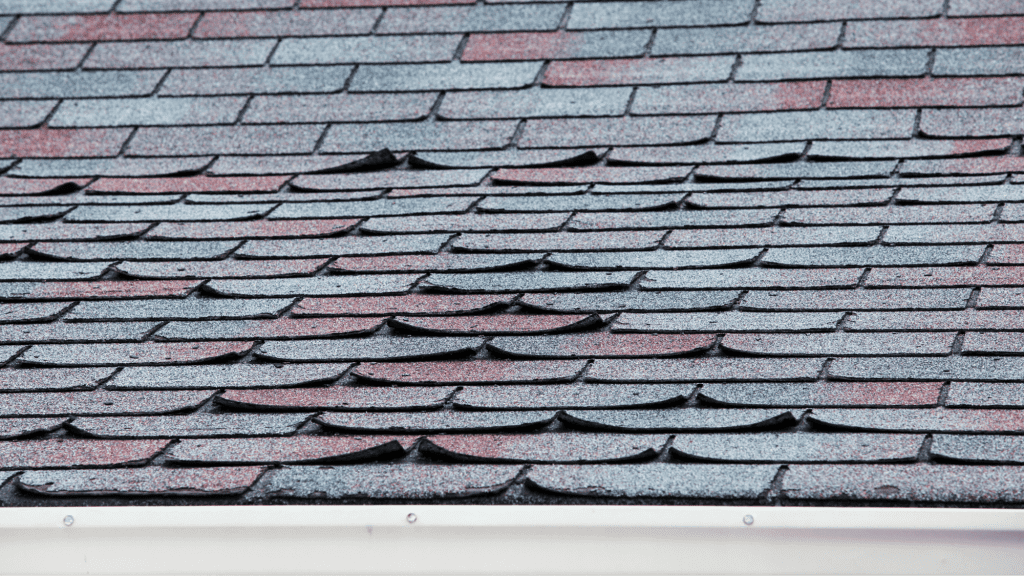
Navigating the process of filing an insurance claim for roof damage in Stow, Ohio requires a well-thought-out approach. From meticulous documentation of the damage to effective collaboration with insurance adjusters and making wise decisions when choosing a roofing contractor, each step is crucial for a successful claims process.
This guide provides a comprehensive overview, guiding you through the necessary steps and offering valuable tips to ensure a smooth and successful insurance claim experience for roof damage.
Documenting the Damage
Before filing an insurance claim for roofing damage, it is crucial to maintain a detailed documentation process. Follow these steps:
- Photograph the affected areas extensively, emphasizing any missing shingles, raised flashing, or damaged tiles.
- Prepare a comprehensive list of the damage, accompanied by detailed notes, including dates, times, and relevant weather conditions contributing to the damage.
- If preventive measures have been taken, such as securing tarps to the roofing, document these measures through photographs.
After documenting the damage, seek an estimate from a certified roofing contractor to assess the repair or replacement costs. This estimate not only clarifies the extent of the damage but also serves as critical documentation when presenting your claim to the insurance company. Maintaining a thorough and accurate record of the roofing damage significantly improves the chances of a successful claim.
Working with Adjusters
In Stow, roof damage evaluation involves the integral role of insurance adjusters in determining the value of your claim payout. Collaborating effectively with these adjusters is paramount for securing the best possible outcome for your claim. It’s crucial to provide accurate information, maintain thorough records of all interactions and pertinent documents, and uphold honesty throughout the process.
When faced with a denied claim, exploring various resolution options is essential:
- Consider asking your insurance company for a different adjuster to obtain a second opinion.
- Alternatively, engaging a structural engineer for a comprehensive inspection and evidence of the damage is a viable step.
- As a last resort, legal avenues can be pursued.
Understanding the adjusters’ role and being well-prepared to work with them increases the likelihood of a successful claim. This ensures you receive the necessary coverage to repair or replace your roof damaged in Stow.
Choosing a Reputable Roofing Contractor
The choice of a reputable roofing contractor plays a vital role in ensuring both quality work and a smooth insurance claims process. When investigating roofing contractors for insurance claims, it’s essential to consider factors such as their experience with claims, turnaround times, and their ability to collaborate with adjusters. A qualified roofing contractor excels in accurately documenting damage according to insurance companies specifications and providing expert assessments.
Opting for a local and reliable roofing contractor, such as Pine Ridge Roofing, provides peace of mind regarding the handling of your roof repair or replacement. Their team of certified roofers and insurance specialists is committed to assisting with storm repair, restoration, and insurance claims in Stow, OH, and the neighboring areas. Choosing an experienced roofing contractor is a surefire way to guarantee the safety and integrity of your home.
Stow Roof Damage - Preventative Measures and Maintenance

While insurance serves as a financial safeguard against roof damage caused by adverse weather conditions, adopting preventative measures is equally crucial. Routine inspections, proper ventilation, and robust waterproofing are key elements in preserving the integrity of your roof. By prioritizing these preventive actions, you can significantly reduce the risk of weather-related damage, mitigating the need for expensive repairs or replacements in the long run.
Routine Inspections
Regular roof inspections serve as an effective method to spot and tackle potential issues before they escalate into significant problems. Inspections should evaluate the roof for signs of:
- Deterioration
- Missing or damaged shingles
- Debris in the gutters
- Roof ponding
Regular roof inspections are highly recommended, especially in areas prone to extreme weather conditions. Conducting these inspections at least twice a year is essential for proactive maintenance.
By identifying and addressing minor issues early on, you can avoid costly repairs or the need for a complete roof replacement. For a thorough and expert assessment, consider hiring Pine Ridge Roofing, a reputable contractor known for maintaining roof integrity. Schedule your free roof inspection today and ensure the longevity of your roof.
Proper Ventilation and Waterproofing
Shielding your roof from the adverse effects of moisture buildup, ice dams, and other weather-related damage requires a focus on proper ventilation and waterproofing. This includes:
- Maintaining good indoor air quality
- Implementing effective home ventilation strategies
- Utilizing exhaust fans and air purifiers
- Installing a reliable ventilation system
- Ensuring the correct attachment of roof ventilation products.
Neglecting these aspects may result in problems like moisture accumulation and ice dams, potentially leading to costly repairs and replacements. Prioritizing adequate roof ventilation and waterproofing is key to reducing the risk of damage and prolonging the performance and lifespan of your roofing materials.
Pine Ridge Roofing: Your Partner in Roof Repair and Insurance Claims
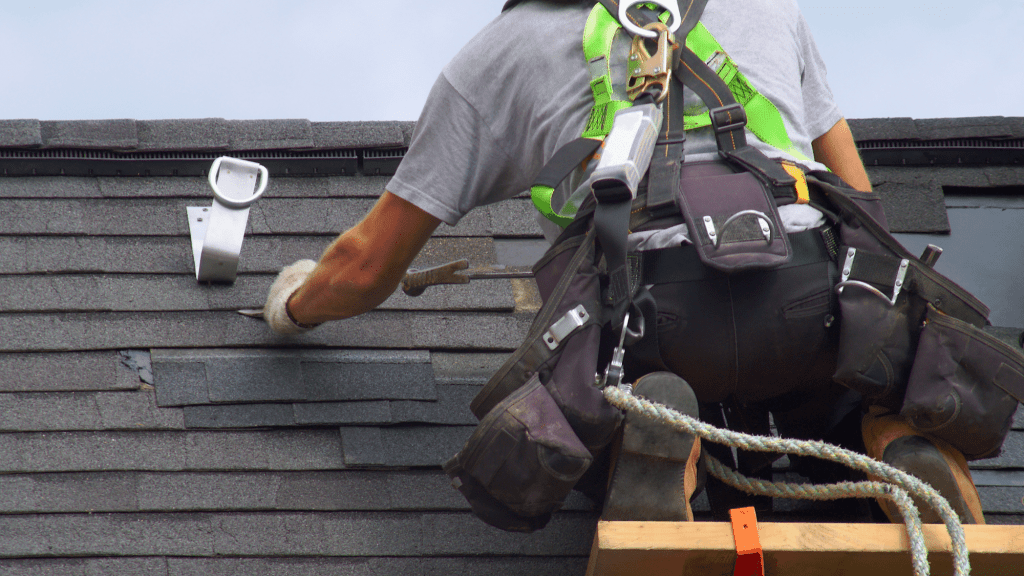
Pine Ridge Roofing, serving Stow, Ohio, and surrounding areas, specializes in:
- Storm damage repairs
- Insurance claims
- Emergency inspection
- Tarping services
- Assistance with insurance claims for weather-related roof damage
- Roof replacements
- Siding repair and replacement
- Gutter repair and replacement
- Leaf Guard Installation
- Deck building
With a combined experience exceeding 25 years, our team of certified roofers and insurance specialists is unwavering in its commitment to providing excellent roof repairs. We are dedicated to safeguarding and restoring your home following any weather-related damage event.
Emergency Inspection and Tarping Services
When roof damage is suspected, don’t hesitate to schedule a complimentary emergency inspection with Pine Ridge Roofing. This inspection is instrumental in assessing the damage’s extent, facilitating informed decisions on necessary repairs or replacements. Our team of professionals conducts a comprehensive evaluation of your roof, identifying issues such as missing shingles, raised flashing, or cracked tiles that require immediate attention.
In addition to emergency inspections, Pine Ridge Roofing provides the following services:
- Our tarping services offer temporary protection, preventing further damage to your roof.
- Act promptly by securing your roof with tarps to minimize the risk of additional damage.
- We ensure your home remains safe and secure throughout the insurance claim process.
Insurance Claim Assistance
Navigating the insurance claim process can be overwhelming, but Pine Ridge Roofing is here to help. They offer the following services:
- Assisting with insurance claims
- Representing homeowners
- Negotiating with insurance companies
- Providing quality roof replacement services
Pine Ridge Roofing’s proficiency in insurance claims ensures that you achieve the optimal outcome, letting you focus on the safety and well-being of your family. Their insurance claim support involves:
- scheduling emergency inspections
- tarping damaged areas
- representing homeowners during insurance adjuster meetings
- negotiating with insurance companies
- utilizing high-quality products like Owens Corning shingles and synthetic felt for roof replacements.
With Pine Ridge Roofing, be confident that your roof repair or replacement will be managed with professionalism and efficiency, providing you peace of mind and the security of a well-protected home.
Summary
The challenge of weather-related roof damage in Stow, Ohio is one that every homeowner may face. It’s crucial to comprehend the diverse types of damage, adeptly manage the insurance claim process, and take proactive steps for roof maintenance. Armed with the insights from this comprehensive guide and the support of Pine Ridge Roofing, a reputable contractor, you can face weather-related roof damage with confidence, assuring the safety and security of your home and family.
Frequently Asked Questions
Does Home Insurance Cover Roof Storm Damage?
The coverage of roof storm damage in your home insurance policy is contingent on the specific details outlined in the plan. Typically, insurance plans provide coverage for damage resulting from hail, strong winds, destruction caused by falling objects, and internal damage due to roof storm damage. If a storm results in the destruction of your roof and subsequent rainwater damage to the ceiling, your insurance policy is generally designed to cover the repairs for both the roof and ceiling.
Are blown-off shingles covered by insurance?
Insurance companies often grasp the critical importance of a sound roof and usually extend coverage to encompass the expenses linked to replacing a roof, especially when damage occurs due to unpreventable factors like the dislodging of shingles.
What is considered wind damage to shingles?
Wind damage to shingles is typically characterized by tearing, creasing, or detachment from the roof. This usually occurs in three-tab shingles due to repeated lifting or flapping, and unsealed shingles are exempt unless there is physical mat damage.
My roof doesn’t leak. Does this mean my roof is okay?
Even if your roof appears leak-free, it doesn’t guarantee its flawless condition. Roof damage often lurks beneath the surface, remaining invisible until it becomes a significant issue. At Pine Ridge Roofing, our experienced professionals use advanced tools and techniques to detect hidden moisture and identify potential damage not easily visible. Don’t wait for leaks to reveal the problem; schedule a complimentary inspection with us today!
What is the most common roof damage?
Roof damage in Stow, OH frequently manifests as leaks, typically attributed to issues like damaged shingles, improper flashing near chimneys or gutters, and surrounding vents or pipes.
